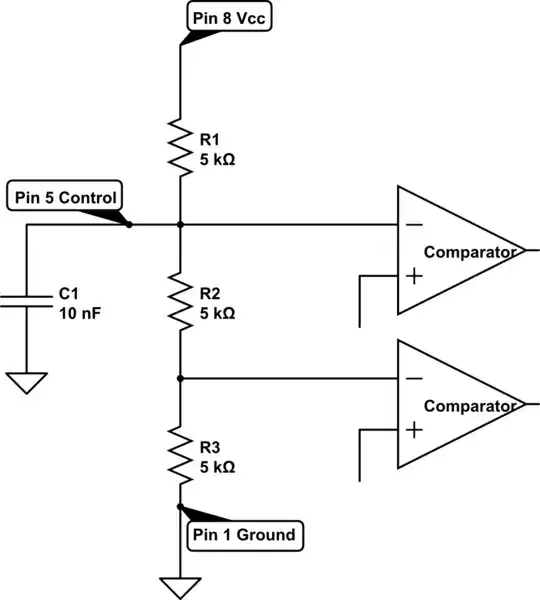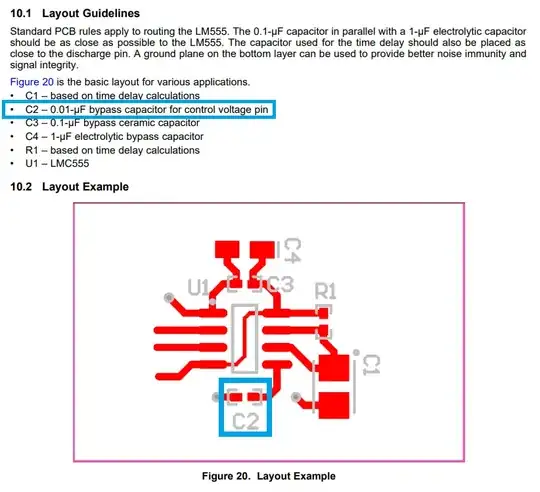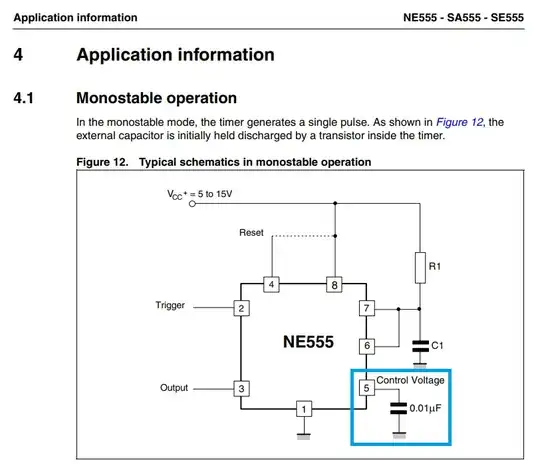Do you really need a capacitor from pin 5 to ground? Some circuits show it, others do not. Timer calculators don't use it when calculating freq and duration of pulses.
-
Input (pin 5) is used for modulation. So, you should use a capacitor. – Antonio51 Jan 14 '23 at 16:46
-
2It depends on how high the frequency at which your circuit will be running and how stable the circuit needs to be. For most purposes, I would say you'll be fine without it, since the pin 5 is connected to a fairly low impedance voltage divider (in a regular 555, the CMOS 555 has much higher impedance divider, so I would recommend using a cap there). Pin 5 is used for changing threshold voltages on the inputs, or for "modulation", but left unused is better with a capacitor to ground. – Edin Fifić Jan 14 '23 at 16:54
7 Answers
Pin 5 is the Control pin, this can be used to vary the timing with a DC voltage, or to modulate it with an AC signal. It connects to the top tap of the resistive divider that provides the reference voltages for the comparators.

simulate this circuit – Schematic created using CircuitLab
When not using this pin it's recommended to add a capacitor to ground, this helps filter noise on the reference voltages. It's not absolutely necessary though, and many designs leave it out as a cost cutting measure for large production runs where the small cost of a capacitor can add up. For one-offs there's no benefit to leaving it out.
- 22,826
- 1
- 20
- 58
-
3in case some people do not realize: R1 and C1 form an RC filter which somewhat protects the comparator voltages against power supply noise/ripple. – user253751 Jan 15 '23 at 07:00
Without it, there can be variations in the timing. With it, the output frequency and duty cycle are more stable. It costs you next to nothing to add it in, so go ahead and add it.
- 21,104
- 6
- 34
- 73
-
OK, great. I should've asked before I made my boards. D'oh! I can probably add the cap anyway as the leads are long enough to straddle the trace and get to ground. Thanks. – user242509 Jan 15 '23 at 19:06
No, you may not need it and it is not mandatory, but it may make things better. You should read the datasheet how to use the part for further info.
Direct quote from TI datasheet:
Decoupling CONT voltage to ground with a capacitor can improve operation. This should be evaluated for individual applications.
There is just so many manufacturers and different versions of 555 so check the correct data sheet for your specific part.
- 147,557
- 4
- 113
- 291
You can leave it out and it will function. The timing might be a bit shorter, but if you don't care much about the exact (time or frequency) you can go for it. Eg. for something like driving MOSFET for a step-up transformer where frequency within +/-30% is no problem.
If memory serves, in a typical circuit adding it has about a 10% effect (lower frequency).
As the trip point approaches the 555 is sensitive to noise on the power supply, having a capacitor there can help if your power supply rail is not quiet because it effectively provides a low-pass filter on the divider network. A 10nF cap yields about a cutoff frequency of about 5kHz for a bipolar 555 and perhaps 500Hz for a CMOS 555.
- 397,265
- 22
- 337
- 893
A capacitor (with no other components) on that pin is strictly a noise filter. Hans said it is strongly recommended, but has no effect on timing unless the cap is leaky.
- 19,998
- 1
- 13
- 32
If in doubt, read the data sheet: -
Diodes Inc. also suggest it here: -
ST's data sheet is similar: -
- 456,226
- 28
- 367
- 807
-
Comments are not for extended discussion; this conversation has been moved to chat. – Russell McMahon Jan 17 '23 at 10:07
It is hard to know why the designers made this node accessible. If you have a very clean power supply, the capacitor is not necessary. If not then it is necessary to provide a clean reference.
If the supply voltage is clean but is not steady then a capacitor here is ineffective. An external stable low impedance reference voltage can be applied here to prevent unwanted modulation effects.
- 15,016
- 2
- 10
- 38
-
4The pin is accessible because it allows an useful function, modulation with an external control voltage. – Justme Jan 14 '23 at 20:56
-
3"It is hard to know" - not really. Hans Camenzind died in 2012, and gave many interviews over the decades since he invented the 555. – AnalogKid Jan 15 '23 at 17:17


